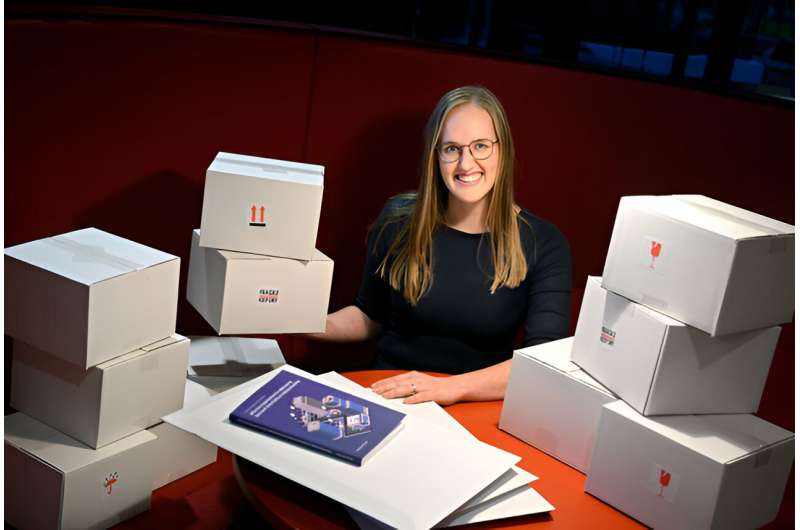This article has been reviewed according to Science X's editorial process and policies. Editors have highlighted the following attributes while ensuring the content's credibility:
fact-checked
trusted source
proofread
Coping with uncertainty in customer demand: How mathematics can improve logistics processes

How do you distribute drinking water fairly across an area recently hit by a natural disaster? Or how can you make sure you have enough bottles of water, granola bars and fruit in your delivery van to refill all the vending machines at a school when you don't know how full they are?
Eindhoven University of Technology researcher Natasja Sluijk has developed mathematical models to address these challenges in transportation planning. On Thursday 23 November she successfully defended her dissertation at the Department of Industrial Engineering & Innovation Sciences.
Sluijk obtained her master's degree at Erasmus University in the field of Operations Research, an area of research focused on the application of mathematical methods in order to optimize processes.
"I've always been interested in mathematics and I decided I wanted to do something with it," she says. On top of that, her father and grandfather, both of whom used to be truck drivers, fueled her interest in transportation and logistics. "That's how the seed was planted." The Ph.D. candidate is also very intrigued by uncertainty. "Well, in my research that is, not in my life," she adds with a laugh. Her doctoral research is where these worlds meet.
Reducing emissions
Her dissertation can be divided into two parts. The first part focuses on so-called two-echelon distribution. "First, you transport the goods in big trucks, because that way you can take many items at once, so you need fewer drivers and you reduce the costs," she explains.
However, due to environmental zones and emissions regulations, trucks cannot enter cities, which is why smaller vehicles take over the goods at the city limits and bring them to their final destination. These include bicycle couriers or electric vans, which are smaller and more compact.
By dividing the distribution chain into two steps, you can keep costs low while still complying with regulations. Not only does the use of greener vehicles in cities reduce emissions, it also reduces noise pollution and parking problems. "These are the reasons why more and more research is being conducted on two-echelon distribution, on how to optimize it and how to plan routes efficiently," says Sluijk.
Customer demand uncertainty
The primary focus of her doctoral research is dealing with uncertain customer demand. Normally, a route plan is drawn up for a set of customers with known locations and demands. But what if you don't know in advance exactly how much you need to deliver?
Sluijk did not include home package deliveries in her research, but rather focused on deliveries from companies to other companies, the so-called B2B market. "Think, for example, of deliveries to locations that require product restocking, such as vending machines," she explains.
"What you can see in advance is how much has been sold, but it's only when you arrive at the vending machine that you can see the current demand. Basically, between the time of planning and the time of delivery, the demand can change." As such, the challenge here is to meet all demands without being left with a surplus of goods.
Sluijk has developed exact mathematical models and algorithms that allow for better handling of uncertain customer demand and optimal route planning solutions within a two-echelon distribution. This enables us to improve the structure of the two-echelon distribution system, making it more sustainable and cost-efficient.
"The most optimal solution ultimately depends on the company's exact goals," she emphasizes. Do they want as many satisfied customers as possible or do they prioritize low costs? The mathematical models make it possible to calculate different scenarios and, for example, accurately assess how enhancing customer service affects costs.
Fair distribution
In the second part of her dissertation, she focuses on situations where the total demand exceeds the capacity, in other words, the amount you can supply. Besides cost and efficiency, fairness is another important consideration here.
"For example, I arrive at a customer who asks for eight items, but I decide to supply only six so that I have enough left for the other customers in the delivery route. If I don't do this, I disadvantage the customers later in the route," she explains.
The key question here is: how do you ensure a fair distribution of goods when the customer demand is uncertain? Sluijk developed mathematical models that ensure everyone is treated equally. "This is something that has to be done proportionally, because if a customer asks for a hundred items, supplying one fewer item is much less of an issue than if they asked for only five items. So that's how we factor that in," she explains.
Humanitarian organizations
The models are applicable not only in B2B supply chains, but also in non-commercial sectors, such as humanitarian organizations. "Suppose there has been a natural disaster and you need to deliver water to different locations, but you don't know exactly how much to deliver to each location," she says.
"The same thing applies to food banks; they often collect the food at a central location and then distribute it among the regions." In these situations, it is crucial to fairly distribute the available resources between the different locations.
Here, the exact methods she has developed can be of great help. "However, we still need to bridge the gap between theory and practice; but in principle, the models are widely applicable and provide a good starting point in the search for desirable solutions. Not only do mathematical models help you arrive at solutions, they also allow you to properly substantiate the decisions made. That is the most transparent approach and also prevents arguments," she concludes.
More information: From Chaos to Control: Effective Approaches for Addressing Demand Uncertainty in Vehicle Routing. research.tue.nl/nl/publication … r-addressing-demand-
Provided by Eindhoven University of Technology


















